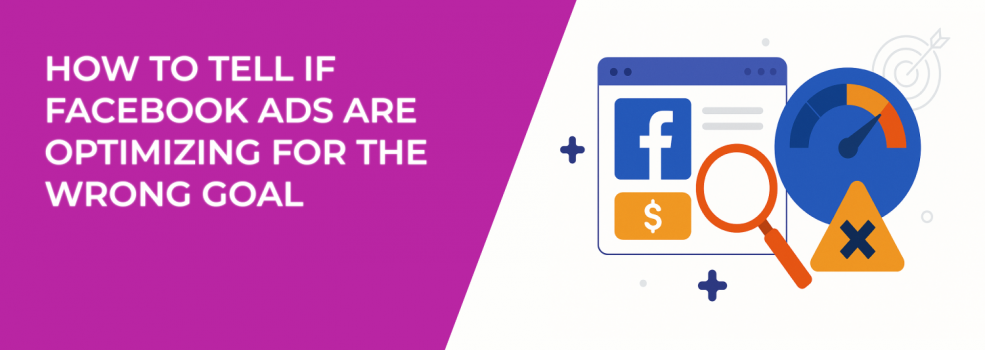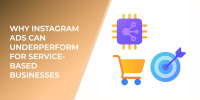Are your Facebook ads producing surface-level metrics — like clicks or impressions — but falling short on real business outcomes? Maybe you're getting strong traffic, yet sales are inconsistent or flat. Or your campaign spends your entire daily budget, but the conversions just don’t show up.
This often points to a silent but critical issue: your campaign may be optimizing for the wrong goal.
It’s one of the most overlooked problems in Meta Ads. Even when you’ve correctly selected a conversion objective, the Facebook algorithm can drift — subtly prioritizing cheaper or easier actions over the outcomes that actually drive growth for your business.
Understanding when this is happening — and knowing how to realign the algorithm — is essential for consistent, profitable performance.
The Goal You Set Doesn’t Always Equal the Goal Facebook Pursues
When launching a Facebook campaign, advertisers are asked to choose an objective. This includes options like “Traffic,” “Engagement,” “Leads,” or “Conversions.” These objectives are supposed to guide how Facebook optimizes your campaign in the auction and delivery process.
But here’s where it gets tricky: while your campaign objective tells Facebook what you want, the algorithm often decides how to get there based on early signals.
This means your conversion campaign may not truly be optimizing for conversions. If Facebook identifies a pattern that suggests it’s easier to get someone to click a link than to submit a lead form or complete a purchase, it may gradually optimize toward the easier outcome — even if that’s not what your business needs.
Facebook optimizes for what’s most efficient based on early feedback, not necessarily what’s most meaningful to you.
And that’s a dangerous disconnect.
To make sure you’re using the right objective for your desired outcome, see Meta Ad Campaign Objectives Explained.
Signs That Your Facebook Campaign Is Optimizing for the Wrong Goal
If you know what to look for, there are clear warning signs. These red flags often show up in performance data — but only if you’re analyzing the right metrics in the right context.
Let’s break them down:
1. High Click-Through Rate (CTR), Low Conversion Rate
At first glance, a high CTR can seem like a win. Your ads are clearly capturing attention. But if that attention doesn’t translate into meaningful actions — like purchases, sign-ups, or booked calls — you have a problem.
In this case, the algorithm may be favoring people who click, not people who convert. Clickers are cheap and easy to find, and Facebook can hit your “result” targets faster this way. But it undermines your goal if the clicks aren’t from qualified or interested users.
2. Lots of Page Views, Very Few Leads or Sales
If you see high numbers for “View Content” or “Landing Page Views,” but your CRM or sales dashboard shows minimal activity, you’re probably attracting low-intent traffic.
This often happens when advertisers optimize for upper-funnel actions (sometimes by accident), or when Facebook defaults to audiences who are likely to click but unlikely to take the next step.
3. Strong Start, Then Sudden Drop-Off in Results
You launch the campaign. Results look promising for the first few days. Then, performance flatlines.
Why? Facebook may have locked in a low-quality audience during the Learning Phase. If the algorithm picks up weak signals early — like users who engage but don’t convert — it can keep targeting more people like them. That early misalignment can spiral into long-term underperformance.
If that sounds familiar, here’s what to do: What to Do When Your Facebook Ads Suddenly Stop Converting.
4. Mismatch Between Facebook's Reporting and Real-World Outcomes
If Facebook is reporting a decent cost per conversion, but your back-end data (like Shopify, Stripe, or your CRM) shows a different story, question Facebook’s tracking.
Meta Ads Manager may count events like “Initiate Checkout” or “Add to Cart” as successes, while your actual sales numbers remain low. This discrepancy often indicates the algorithm is favoring micro-conversions over true outcomes.
This is when it’s time to reframe your analysis. How to Analyze Facebook Ad Performance Beyond CTR and CPC shows how to dig into meaningful data.
Why the Algorithm Gets It Wrong — and How That Affects You
Facebook’s optimization engine is built for scale and speed. It wants to find a repeatable pattern that delivers results — quickly and affordably. During the Learning Phase, it runs thousands of small tests across placements, audiences, and behaviors, searching for common signals.
But sometimes, what’s easiest for Facebook to deliver isn’t what’s best for your business.
Here’s an example: say you’re running a lead generation campaign with the goal of acquiring demo bookings. Early on, a few users fill out a form but don’t actually schedule anything. Facebook sees this activity and begins prioritizing similar users — people who start the process but never follow through.
As the algorithm scales, you start getting a high number of form submissions — but when you look closely, they’re mostly low-quality leads who never convert.
Result: the algorithm believes it’s performing well, while your sales team is stuck with junk leads.
This is the hidden cost of misaligned optimization — and it can quietly bleed your ad budget for weeks before you realize it.
How to Steer Facebook Back Toward the Right Goal
Reclaiming control over optimization isn’t about gaming the system. It’s about giving Facebook clearer, more structured signals — so it knows what kind of users matter most.
Here’s how to make that happen:
1. Choose the Most Specific, High-Value Conversion Event
Avoid defaulting to “View Content” or “Add to Cart” just because they show more volume. Select the deepest, most business-critical event you can reliably track — whether that’s a purchase, booked consultation, or completed sign-up.
If your funnel includes multiple steps, create and track custom conversions tied to the last meaningful action in the sequence. This ensures Facebook is optimizing for the end result, not just the beginning of the user journey.
2. Avoid Rushing to Scale Based on Early Engagement
Let your campaigns mature. Facebook needs time to understand what kind of user converts — not just clicks. If you scale too fast based on early results, the algorithm may reinforce the wrong audience behavior.
Watch for consistency over time, not just quick wins.
3. Implement Custom or Value-Based Conversions
Instead of tracking every lead equally, assign different values based on lead quality or expected revenue. This works especially well for service-based businesses, SaaS, or high-ticket sales funnels.
Facebook’s value optimization allows you to prioritize customers who are more likely to generate actual revenue, not just surface-level actions.
4. Split Test Optimization Events to Find the Right Fit
Test different optimization events in controlled campaigns. For example, run two identical ad sets — one optimizing for “Leads” and another for “Scheduled Appointments.” Compare results not just on cost, but on downstream metrics like lead-to-close rate or average order value.
You might discover that optimizing for a slightly lower-volume event leads to better business results overall.
5. Use Exclusions to Prevent Low-Intent Feedback Loops
If your campaigns have been running for a while, your pixel may be collecting noise. Exclude audiences that have engaged but never converted, or people who frequently click ads without taking meaningful actions.
This helps the algorithm focus on higher-intent users and prevents it from getting trapped in a loop of low-quality optimization.
Ask Yourself: Are You Measuring Success by the Right Metric?
It’s easy to fall into the trap of judging success by the numbers Facebook shows you. Cost per click, CTR, engagement rate — these can all look impressive. But are they translating into revenue?
Always cross-check ad platform performance against business outcomes.
Ask:
-
Are these leads converting into paying customers?
-
Is my cost per result sustainable at scale?
-
Do these users take meaningful action — or just bounce after the click?
If the answers make you uncomfortable, that’s a sign your campaign may be optimized for the wrong behavior. Don’t let the algorithm chase vanity metrics. Guide it back toward value.
Final Thoughts
Facebook’s optimization engine is a powerful tool — but it needs direction. If you don’t provide the right signals, it will find the path of least resistance, not the path to profit.
The key isn’t to work against the algorithm. The key is to work with it — but on your terms.
So review your goals. Audit your data. Dig into the numbers that really matter. Because if your campaign is optimizing for the wrong thing, every click is just another step in the wrong direction.

